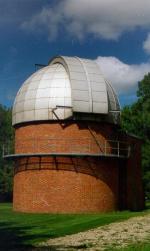| Warner and Swasey Observatory |
| Case Western Reserve University | Nassau Station |
| Visitors |
|
» Home » News » Gallery » Reference » Weather |
| Science Resources |
|
» NSRT User Interface » Software » Data Archive » Download Data |

|
 |
Image Processing
Once you have gathered your raw data, there are some corrections that have to be made to compensate for imperfections in the CCD, imperfections in the sky, and fringing caused by filters. These things are done to your data for you, so you do not have to worry about learning how to use the software or interface. The Image Reduction and Analysis Facility (IRAF) is what astronomers use to manage and manipulate their data. It is important for you to understand what is done to your data, and why these things have to be done. Depending on what you want to do with your data, you may or may not have to worry about the following factors.
Removing Telescope Bias: Each image taken by the telescope has a bias or pedestal level of a few hundred ADUs which varies slightly depending on the position on the chip. The exact level has to be determined for each individual frame, averaged, and then a function (which may be as simple as a constant) has to be fitted to this data so that the telescope bias can then be subtracted off. A little bit of data from the first and last few columns is usually lost during this process, but the great majority is left, and is now cleaner.
Zero Framing: Additional garbage needs to be removed from the images which may be the result of residual variations in the bias level or pre flashing. Frames are obtained with zero integration time, and these zero frames are averaged, and then a fit is done to these frames, as with the telescope bias before.
Subtracting Dark Frame: The dark current is additive, and it continues to increase as long as the shutter is open. In order to know how many counts are the products of the dark current, dark exposures are made. Dark exposures are long integrations with the shutter closed. Frames are processed and scaled to the exposure times that were used for the images. Unfortunately, this does not scale linearly, so it is often troublesome, and sometimes not worth doing.
Flat Fielding: In order to remove variations in sensitivity, pixel-to-pixel gain variations, possible spatial variations, and just plain bad pixels, an average flat field is divided out of the frames. Basically, the natural variations in the CCD are observed, and the non-uniformities are corrected for in the images. Usually when the flat field exposures are combined, cosmic rays are eliminated from the images. The trick is to do it for several frames so that these events can be identified and isolated.
Fringe Removal: Fringes patterns appear in the images from the different filters that are used. These have to be subtracted from each frame. Master fringe patterns are constructed for each filter used. For two minute exposures, the variations in intensity that take place during the night are not an issue, but for longer exposures, astronomers must also worry about the changing intensity of the fringe lines.
Flexible Image Transport System (FITS)
After all of these changes have been made, your image file is sent to you in the FITS format. Unlike jpeg, gif, tiff, or other image compression systems, FITS does not discard data during compression. FITS is not a color map, like these other systems, it is a system of storing all the data taken by the telescope. In order to see the image, you need to have a FITS viewer.
Back to the NSRT Reference page
Created by Marta Lewandowska, June 1999